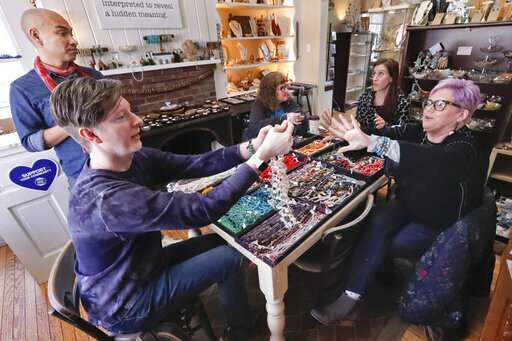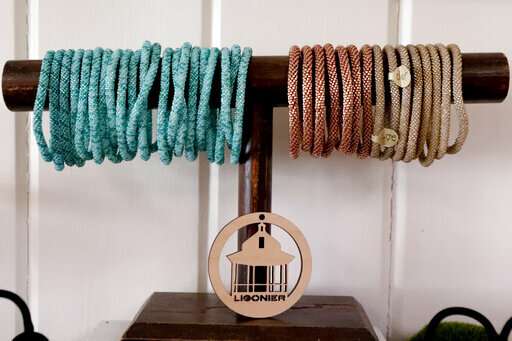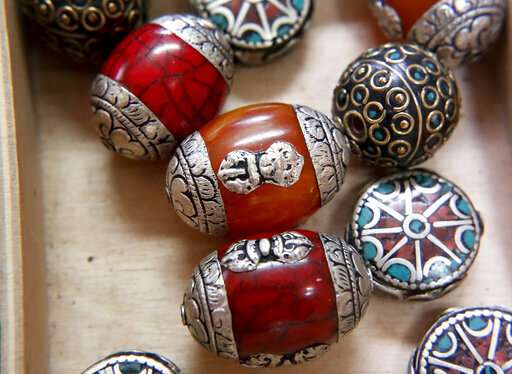In this Thursday, Feb. 28, 2019, photo a customer at Allegory Gallery, Denise Glover, right, hands her selections to William Jones, one of the co-owners of the jewelry and art store, as fellow owner Andrew Thornton, left, talks with instructor Laurel Ross, center right, and client Cindy Kuhns, center left, in the small town of Ligonier, Pa. Social media is a resource Thornton and Jones use to stay on top of trends by connecting with customers. (AP Photo/Keith Srakocic)
When small business owners want to divine what consumer spending trends will be months from now, their methods can be as sophisticated as internet analytics or as basic as plain old intuition.
At Moriarty's Gem Art, co-owner Jeff Moriarty tracks searches on the jewelry company's website and on Google Trends, a site that analyzes what people are looking for online.
"If we see a gemstone or a style of ring or certain metal type gaining popularity in a Google Trends report, we'll create pieces and see how they sell," says Moriarty, whose company is located in the Chicago suburb of Crown Point, Indiana.
While current sales trends are important for small retailers and manufacturers, it can be more critical to get a sense of what the next big seller will be, whether it's the hot toy during the holiday season, a fashion silhouette or a smartphone. Owners can get clues from internet searches, and deeper insights by looking at the data creatively and discerning how consumer tastes are changing. Knowing what's in the style and manufacturing pipeline can also help in anticipating trends.
Social media is another resource. Andrew Thornton and William Jones stay on top of trends by connecting with the customers of their jewelry and bead store.
In this Thursday, Feb. 28, 2019, photo co-owner Andrew Thornton touches one of his rings as he talks about his jewelry and art store, Allegory Gallery, in the small town of Ligonier, Pa. Thornton says social media is a resource they use to stay on top of trends by connecting with their customers. (AP Photo/Keith Srakocic)
"Social media helps inform your understanding of consumer psychology and allows you to plan accordingly and make changes," says Thornton, co-owner of Allegory Gallery in Ligonier, Pennsylvania. "It can be useful to learn who your customer is and figure out how to better serve them."
Apparel retailers should follow blogs and social media accounts of people in the fashion industry, including stylists who select clothes for celebrities, says Bob Phibbs, owner of The Retail Doctor, a consulting business. Phibbs noted that Walmart commercials during the telecast of last month's Academy Awards featured well-known Hollywood stylists.
"Follow them on Instagram and see what they're dressing people in," Phibbs says.
Taylor Mack stays on top of book trends on Instagram, where book lovers connect at #bookstagram. Mack, who owns SilverFire Books, an online used book store, says she's able to engage with customers on social media, and also see what they want.
"I do market research by taking social cues from what users post on Instagram—the products they're buying, the buzzworthy books they're reading, and their lifestyles," says Mack, who lives in Issaquah, Washington.
In this Thursday, Feb. 28, 2019, photo co-owner of Allegory Gallery Andrew Thornton talks about how he and William Jones are using social media to help keep their jewelry and art store in operation in the small town of Ligonier, Pa. (AP Photo/Keith Srakocic)
Owners need to look creatively at sales or search data, no matter where they get it, to try to predict what's next, says Marshal Cohen, a senior analyst at NPD Group, a company that tracks consumer trends. Two years ago, Cohen saw signs that loungewear sales were going to increase. He forecast that sales of products people use when they're staying close to home—such as board games and cookware—would also increase, and they did.
"The art is being able to interpret the trend that helps you begin to gain insight into tomorrow," Cohen says.
Savvy owners will try to anticipate the end of a current trend. For example, if a color or style has been popular for a while, it may be about to wane as consumers want something new and different.
"You use the trends to try and pick the next style. That's where your intuition comes in," says Joanna Duda, owner of Pirillo Swimwear, a Chicago-based online retailer of women's swimsuits. Duda has seen a lot of yellow clothes in recent seasons, so she's turning to other hues for her upcoming collection.
While some owners go to trade shows or expos to spot likely trends, or ask their manufacturer vendors, Phibbs warns that may not be the best approach. For one thing, the merchandise at trade shows may not be as new as it looks. Phibbs says there's a lot of repetition as manufacturers have copied one another, and their merchandise has likely been shown on the internet already.
In this Thursday, Feb. 28, 2019, photo a selection of bracelets are displayed for sale at the Allegory Gallery shop in the small town of Ligonier, Pa. Social media is a resource owners Andrew Thornton and William Jones use to stay on top of trends by connecting with customers. (AP Photo/Keith Srakocic)
Moreover, Phibbs says, manufacturers want to sell you what's in their inventory—they want to clear it out so they can move on to their next line. A better strategy is for a small business to make itself a big, and therefore more important, customer for a manufacturer, he says
"When you're a bigger fish, they come to you and say, 'we're thinking of this for next year,'" Phibbs says. That way, a small business can get the jump on competitors.
But some trade shows do help owners forecast what trends will be. Thornton and Jones head to Tucson, Arizona, every January and February for a series of jewelry, gem and bead shows. They see the raw materials that go into jewelry, and learn what new stones, beads and other jewelry components are headed to market.
"We're seeing what is available before it's available," Thornton says.
In this Thursday, Feb. 28, 2019, photo Tibetan hand-made beads are displayed among hundreds of other beads available for sale at the jewelry and art store, Allegory Gallery, in the small town of Ligonier, Pa. Social media is a resource store owners Andrew Thornton and William Jones use to stay on top of trends by connecting with customers. (AP Photo/Keith Srakocic)
While analyzing search data from Google and also Amazon.com is important for Kelly Hsiao and Will von Bernuth as they run their skin care products business, so are news reports. The owners of Block Island Organics get alerts on their phones so they'll know when a law is passed or study issued about skin care and sunscreen products or their ingredients. Consumers can react to the news, and the couple may have to pivot, especially if there's a new law.
Last month, the Food and Drug Administration proposed new regulations governing sunscreens.
"It could change our entire business," Hsiao says.
© 2019 The Associated Press. All rights reserved.



























